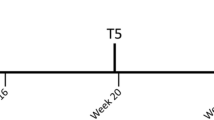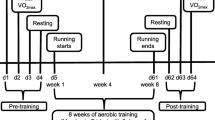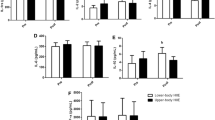Summary
Five subjects undertook 10 days of twice daily interval training sessions on a treadmill followed by 5 days of active recovery. On days 1, 6, 11, and 16 the subjects were required to undertake a test of submaximal and maximal work capacity on a treadmill combined with a performance test consisting of a run to exhaustion with the treadmill set at 18 km · h−1 and 1% gradient. Also on these days a pre-exercise blood sample was collected and analysed for a range of haematological, biochemical and immunological parameters. The subjects experienced a significant fall in performance on day 11 which had returned to pretraining levels on day 16. Serum ferritin concentrations were depressed significantly from pretraining concentrations at the conclusion of the recovery period while the expression of lymphocyte activation antigens (CD25+ and HLA-DR+) was increased both after the training phase and the recovery phase. The number of CD56+ cells in the peripheral circulation was depressed at the conclusion of the recovery period. Several parameters previously reported to change in association with overload training failing to reflect the decrease in performance experienced by subjects in this study, suggesting that overtraining may best be diagnosed through a multifactorial approach to the recognition of symptoms. The most important factor to consider may be a decrease in the level of performance following a regeneration period. The magnitude of this decreased performance necessary for the diagnosis of overtraining and the nature of an “appropriate” regeneration period are, however, difficult to define and may vary depending upon the training background of the subjects and the nature of the preceding training. It may or may not be associated with biochemical, haematological, physiological and immunological indicators. Individual cases may present a different range of symptoms and diagnosis of overtraining should not be excluded based on the failure of blood parameters to demonstrate variation. However, blood parameters may be useful to identify possible aetiology in each separate case report of overtraining. An outstanding factor to emerge from this study was the difficulty associated with an objective diagnosis of overtraining and this is a possible reason why there have been new accounts of overtraining research in the literature.
Similar content being viewed by others
References
Aldercreutz H, Harkonen M, Kuoppasalmi K, Naveri H, Huhtaniemi I, Tikkanen H, Remes K, Dessypris A, Karvonen J (1986) Effect of training on plasma anabolic and catabolic steroid hormones and their response during physical exercise. Int J Sports Med 7:27–28
Aoki T, Usuda Y, Miyakoshi H, Tamura K, Herberman RB (1987) Low natural killer syndrome: clinical and immunologic features. Nat Immun Cell Growth Regul 6:116–128
Bahr R, Opstad PK, Medbo JI, Sejersted OM (1991) Strenuous prolonged exercise elevates resting metabolic rate and causes reduced mechanical efficiency. Acta Physiol Scand 141:555–563
Banister EW, Calvert TW (1980) Planning for future performance: implications for long term training. Can J Appl Sport Sci 5:170–176
Barron JL, Noakes TD, Levy W, Smith C, Millar RP (1985) Hypothalamic dysfunction in overtrained athletes. J Clin Endocrinol Metab 60:803–806
Behan PO, Behan WHM, Bell EJ (1985) The postviral fatigue syndrome — an analysis of the findings in 50 cases. J Infect 10:211–222
Belcastro AN, Dallaire J, McKenzie DC, Shultz R, Wenger HA (1990) CASS overstress study: blood monitoring. Med Sci Sport Exerc 22:S131
Bompa TO (1983) Theory and methodology of training. Kendall/ Hunt, Duboque, Iowa
Borysiewicz LK, Haworth SJ, Cohen J, Mundin J, Rickinson A, Sissons JGP (1986) Epstein-Barr virus-specific immune defects in patients with persistent symptoms following infectious mononucleosis. Q J Med 58:111–121
Buchwald D, Komaroff AL (1991) Review of laboratory findings for patients with chronic fatigue syndrome. Rev Infect Dis 13:S12–18
Budgett R, Koutedakis Y, Walker R, Parry-Billings M, Newsholme EA (1989) The overtraining syndrome/staleness. Proceedings of International Olympic Committee Conference, Colorado Springs
Caliguri M, Murray C, Buchwald D, Levine H, Cheny P, Peterson D, Komaroff AL, Ritz J (1987) Phenotypic and functional deficiency of natural killer cells in patients with chronic fatigue syndrome. J Immunol 139:3306–3313
Callister R, Callister RJ, Fleck SJ, Dudley GA (1990) Physiological and performance responses to overtraining in elite judo athletes. Med Sci Sport Exerc 22:816–824
Carlile F (1975) The swimmer in stress. Swim Tech 12:34
Carlile F, Carlile U (1959) T wave changes in the ECG associated with prolonged periods of strenuous exercise in sportsmen with special reference to training swimmers. Phys Educ J 17:10–20
Cheny PR, Dorman SE, Bells DS (1989) Interleukin-2 and the chronic fatigue syndrome. Ann Intern Med 110:321
Costill DL (1986) Inside running, chap 5. Benchmark Press, Indianapolis
Costill DL, Flynn MG, Kirwan JP, Houmard JA, Mitchell JB, Thomas R, Park SH (1988) Effects of repeated days of intensified training on muscle glycogen and swimming performance. Med Sci Sport Exerc 20:249–254
Crowell DL, Crouse SF, Hooper PL, Simon TL (1985) Hematological parameters in endurance trained and sedentary men. Med Sci Sport Exerc 17:293
Dill DB, Costill DL (1974) Calculation of percentage changes in volumes of red blood cells and plasma in dehydration. J Appl Physiol 37:247–248
Dressendorfer RH, Wade CE (1983) The muscular overuse syndrome in long-distance runners. Phys Sportsmed 11:116–130
Flynn MG, Pizza FX, Boone JB, Michaud TJ, Andres FF (1990) Indices of overtraining syndrome during a running season. Med Sci Sport Exerc 22:131
Fry RW, Morton AR, Keast D (1991) Overtraining in athletes — an update. Sports Med 12:32–65
Hackney AC, Sinning WE (1986) The effects of wrestling training on reproductive hormones. Med Sci Sport Exerc 20:196
Hakkinen K, Parkarinen A, Alen M, Komi PV (1985) Serum hormones during prolonged training of neuromuscular performance. Eur J Appl Physiol 53:287–293
Hakkinen K, Parkarinen A, Alen M, Kauhanen H, Komi PV (1988) Daily hormonal and neuromuscular responses to intensive strength training in 1 weel. Int J Sports Med 9:422–428
Harre D (1982) Principles of sports training: introduction to the theory and methods of training (in German). Sportverlag, Berlin
Jones JF, Ray CG, Minnich LL, Hicks MJ, Kibler R, Locas DO (1985) Evidence of active Epstein-Barr virus infection in patients with persistent, unexplained illnesses: elevated anti-early antigen antibodes. Ann Intern Med 102:1–7
Keast D, Cameron K, Morton AR (1988) Exercise and the immune response. Sports Med 5:248–267
Kereszty A (1971) Overtraining. In: Larson LA (ed) Encyclopedia of sport sciences and medicine. Macmillan, New York, pp 218–222
Kindermann W (1986) Overtraining — expression of disturbed autonomic regulation. Dtsch Z Sportmed 8:238–245
Kipke l, Rouse J, Dragon J (1986) The importance of recovery after swimming training and competition. Int Swimmer June: 14–16
Kirwan JP, Costill DL, Flynn MG, Mitchell JB, Fink WJ, Neufer PD, Houmard JA (1988) Physiological responses to successive days of intense training in competitive swimmers. Med Sci Sport Exerc 20:255–259
Kuipers H, Keizer HA (1988) Overtraining in elite athletes: review and future directions. Sports Med 6:79–92
Kuipers H, Verstappen F, Keizer H, Guerten P, Van Kranenburg G (1985) Variability of aerobic performance in the laboratory and its physiological correlates. Int J Sports Med 6:197–210
Levin S (1991) Overtraining causes olympic-sized problems. Phys Sportsmed 19:112–118
Lloyd AR, Wakefield D, Boughton CR, Dwyer JM (1989) Immunological abnormalities in the chronic fatigue syndrome. Med J Aust 151:122–124
MacDougall JD, Ward GR, Sale DC, Sutton JR (1975) Muscle glycogen repletion after high-intensity intermittent exercise. J Appl Physiol 42:129–132
McDonald EM, Mann AH, Thomas HC (1987) Interferons as mediators of psychiatric morbidity: an investigation in a trial of recombinant alpha-interferon in hepatitis B carriers. Lancet 11:1175–1178
Neisler HM, Bean MH, Pittington J, Thompson WR, Johnson JT (1989) Alteration of lymphocyte subsets and endocrine response during 42 days of competitive swim training. Med Sci Sport Exerc 21:S110
O'Toole ML, Douglas PC, Hiller WDP (1989) Applied physiology of triathlon. Sports Med 8:201–225
Papa S, Vitale M, Mazzotti G, Neri LM, Monti G, Manzoli FA (1989) Impaired lymphocyte stimulation induced by long-term training. Immunol Lett 22:29–33
Sharp RL, Ness RJ, Hackney AC, Runyan WS (1989) Compatability of aerobic and anaerobic adaptations to training in males. Med Sci Sport Exerc 21:S76
Surkina ID (1982) Stress and immunity among athletes. Sov Sports Rev 17:198–202
Tobi M, Morag A, Ravid Z, Chowers I, Feldman-Weiss V, Michaeli Y, Ben-Chetrit E, Shalit M, Knobler H (1982) Prolonged atypical illness associated with serological evidence of persistent Epstein-Barr virus infection. Lancet 1:61–64
Urhausen A, Kullmer T, Kindermann W (1987) A 7-week followup study of the behaviour of testosterone and cortisol during the competition period in rowers. Eur J Appl Physiol 56:528–533
Wakefield D, Lloyd A (1987) Pathophysiology of myalgic encephalomyelitis. Lancet 11:918–919
Wishnitzer R, Berrebi A, Hurwitz N, Vorst E, Eliraz A (1986) Decreased cellularity and hemosiderin of the bone marrow in healthy and overtrained competitive distance runners. Phys Sportsmed 14:86–100
Author information
Authors and Affiliations
Rights and permissions
About this article
Cite this article
Fry, R.W., Morton, A.R., Garcia-Webb, P. et al. Biological responses to overload training in endurance sports. Europ. J. Appl. Physiol. 64, 335–344 (1992). https://doi.org/10.1007/BF00636221
Accepted:
Issue Date:
DOI: https://doi.org/10.1007/BF00636221




